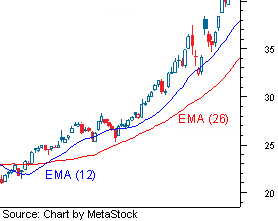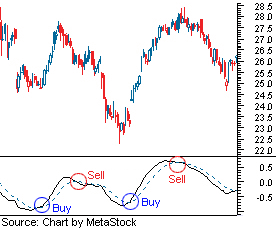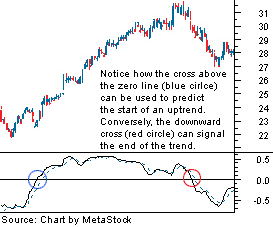Learning to trade in the direction of the short-term momentum can be a difficult task at the best of times, but it is exponentially more difficult when one is unaware of the appropriate tools that can help. This article will focus on the most popular indicator used in technical analysis, the moving average convergence divergence (MACD). This indicator was developed by Gerald Appel in the 1960s and although the name of this indicator sounds very complicated, it's really quite simple to use. Read on to learn how you can start looking for ways to incorporate this powerful tool into your trading strategy.
Background Knowledge
The popularity of the MACD is largely attributable to its ability to be used to quickly spot increasing short-term momentum. However, before we jump into the inner workings of the MACD, it is important to completely understand the relationship between a short-term and long-term moving average.
As you can see from the chart below, many traders will watch for a short-term moving average (blue line) to cross above a longer-term moving average (red line) and use this to signal increasing upward momentum. This bullish crossover suggests that the price has recently been rising at a faster rate than it has in the past and is a common technical buy sign. Conversely, a short-term moving average crossing below a longer-term average is used to illustrate that the price of the asset has been moving downward at a faster rate and that it may be a good time to sell.
Background Knowledge
The popularity of the MACD is largely attributable to its ability to be used to quickly spot increasing short-term momentum. However, before we jump into the inner workings of the MACD, it is important to completely understand the relationship between a short-term and long-term moving average.
As you can see from the chart below, many traders will watch for a short-term moving average (blue line) to cross above a longer-term moving average (red line) and use this to signal increasing upward momentum. This bullish crossover suggests that the price has recently been rising at a faster rate than it has in the past and is a common technical buy sign. Conversely, a short-term moving average crossing below a longer-term average is used to illustrate that the price of the asset has been moving downward at a faster rate and that it may be a good time to sell.
 |
| Figure 1 |
The Indicator
Notice how the moving averages diverge away from each other in Figure 1 as the strength of the momentum increases. The MACD was designed to profit from this divergence by analyzing the difference between the two exponential moving averages. Specifically, the value for the long-term moving average is subtracted from the short-term average and the result is plotted onto a chart. The periods used to calculate the MACD can be easily customized to fit any strategy, but traders will commonly rely on the default settings of 12- and 26-day periods. (For related reading, see Divergences, Momentum And Rate Of Change.)
A positive MACD value, created when the short-term average is above the longer-term average, is used to signal increasing upward momentum. This value can also be used to suggest that traders may want to refrain from taking short positions until a signal is generated that suggests it is appropriate to do so. On the other hand, falling negative MACD values suggest that the downtrend is getting stronger and that it may not be the best time to buy.
Transaction Signals
It has become standard to plot a separate moving average alongside the MACD, which is used to create a clear signal of when the momentum is shifting. A signal line, also known as the trigger line, is created by taking a nine-period average of the MACD and is found plotted alongside the indicator on the chart. As you can see in Figure 2, transaction signals are generated when the MACD line crosses through the signal line (nine-period exponential moving average (EMA) - dotted blue line).
The basic bullish signal (buy sign) occurs when the MACD line crosses above the signal line, and the basic bearish signal (sell sign) is generated when the MACD crosses below the signal line. Traders who attempt to profit from bullish MACD crosses that occur when the indicator is below zero should be aware that they are attempting to profit from a change in the direction of the momentum, while the moving averages are still suggesting that the security could experience a short-term sell off. This bullish crossover can often correctly predict the reversal in the trend as shown in Figure 2, but it is often considered riskier than if the MACD were above zero.
 |
| Figure 2 |
Another common signal that many traders watch for occurs when the indicator travels in the opposite direction of the asset's, known as divergence. This concept takes further study and is often used by experienced traders. (For more on this see, Tales from the Trenches: Trading Divergences In FX.)
The Centerline
As mentioned earlier, the MACD indicator is calculated by taking the difference between a short-term moving average (12-day EMA) and a longer-term moving average (26-day EMA). Given this construction, the value of the MACD indicator must be equal to zero each time the two moving averages cross over each other. As you can see in Figure 3, a cross through the zero line is a very simple method that can be used to identify the direction of the trend and the key points when momentum is building.
 |
| Figure 3 |
Advantages
In the previous examples, the various signals generated by this indicator are easily interpreted and can be quickly incorporated into any short-term trading strategy. At the most basic level, the MACD indicator is a very useful tool that can help traders ensure that short-term direction is working in their favor.
Drawbacks
The biggest disadvantage of using this indicator to generate transaction signals is that a trader can get whipsawed in and out of a position several times before being able to capture a strong change in momentum. As you can see from the chart, the lagging aspect of this indicator can cause several transaction signals to be generated during a prolonged move and this may cause the trader to realize several unimpressive gains or even small losses during the rally.
 |
| Figure 4 |
Traders should be aware that the whipsaw effect can be severe in both trending and range bound markets, because relatively small movements can cause the indicator to change directions quickly. The large number of false signals can result in a trader taking many losses. When commissions are factored into the equation, this strategy can become very expensive.
|
Another drawback of the MACD is its inability to make comparisons between different securities. Because the MACD is the dollar value between the two moving averages, the reading for differently priced stocks provides little insight when comparing a number of assets to each other. In an attempt to fix this problem, many technical analysts will use the percentage price oscillator, which is calculated in a similar fashion as the MACD, but analyzes the percentage difference between the moving averages rather than the dollar amount. (To hear more about the case against the MACD, read Candle Sheds More Light Than The MACD.)
Conclusion
The MACD indicator is the most popular tool in technical analysis because it gives traders the ability to quickly and easily identify the direction of the short-term trend. The clear transaction signals help minimize the subjectivity involved in trading and the crosses over the signal line make it easy for traders to ensure that they are trading in the direction of the momentum. Very few indicators in technical analysis have proved to be more reliable than the MACD, and this relatively simple indicator can quickly be incorporated into any short-term trading strategy.
By Casey Murphy,
Access Investopedia's Forex Advisor FREE Report - The 5 Things That Move The Currency Market
Casey Murphy is the senior analyst at ChartAdvisor.com. He contributes educational articles to Investopedia.com and is a graduate of the University of Alberta School of Business. ChartAdvisor is an independent technical analysis service dedicated to uncovering explosive short-term trading opportunities for individual investors. To learn more about how you can start a free trial and put Casey's insightful analysis and expert pattern recognition to work for you, click here now.
No comments:
Post a Comment